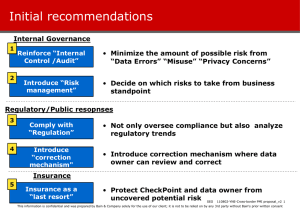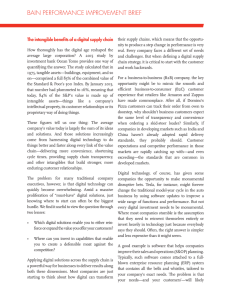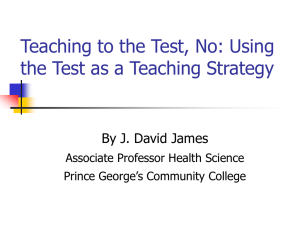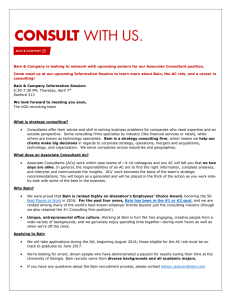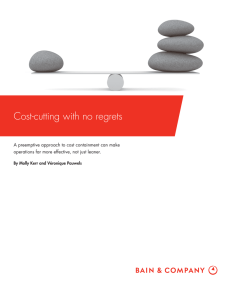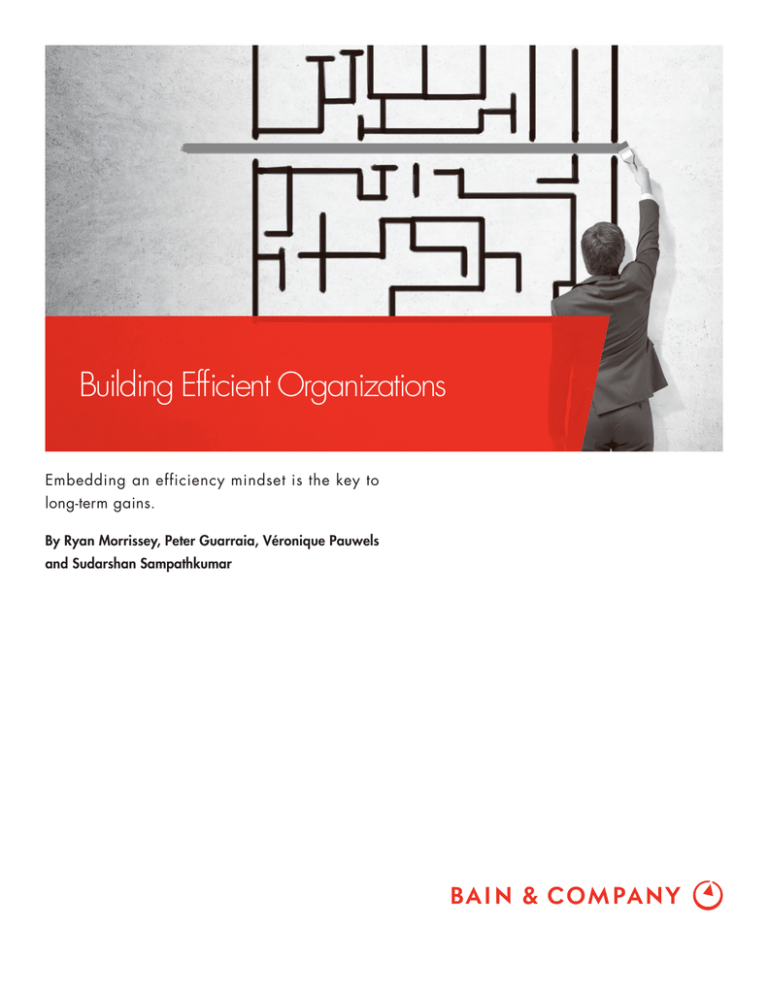
Building Efficient Organizations
Embedding an efficiency mindset is the key to
long-term gains.
By Ryan Morrissey, Peter Guarraia, Véronique Pauwels
and Sudarshan Sampathkumar
Ryan Morrissey and Peter Guarraia are Bain & Company partners based in
Chicago. Véronique Pauwels is a partner based in Amsterdam and the leader of
Bain’s Performance Improvement practice in Europe, the Middle East and Africa.
Sudarshan Sampathkumar is a partner based in Mumbai. They are members
of the firm’s Performance Improvement practice.
Copyright © 2016 Bain & Company, Inc. All rights reserved.
Building Efficient Organizations
adopt an efficiency mindset and identify a few key behaviors that trigger organizational change. While many
companies worry a corporate culture focused on efficiency
will strangle growth or degrade the customer experience,
our research shows the opposite result. Companies that
embrace an efficiency mindset are four times more likely
to say their cost efforts enabled growth rather than hindered it. They also are four and a half times more likely
to report improved customer experience. Australian
telecom Telstra, for example, launched a corporate-wide
efficiency program that removed AUS $3 billion in error
and waste from operational processes while delivering
dramatic improvements in customer experience.
Over the next 12 months, thousands of companies will
launch initiatives to make their operations more efficient.
They will name a leader and a steering committee, build
task forces, assemble project plans, set targets—and
make the initiative top priority. In more than 60% of
these companies, our research suggests, they will target
cost savings of at least 10%—and most of these efforts
will start to deliver modest results (see Figure 1).
But the odds are, before long, the initiative will fizzle
out. Senior executives will move on to other priorities,
task-force members will focus more and more on their
day jobs, and the energy surrounding a once-promising
efficiency effort will fade. At this point, many leaders
confront a universal concern: How do we create an organization that doesn’t rely on one-off initiatives to become
more efficient and keep pace with the competition? How
do we lock in hard-fought gains and build capabilities
for continual improvement?
True, it’s simpler and faster to execute individual efficiency initiatives, such as cost reduction in the distribution
network, and a focused effort can produce clear gains.
But leadership teams taking that approach have difficulty achieving similar efficiencies across functions and
maintaining them over time. Why? The organization
doesn’t build the muscles to sustain long-term change.
Companies that have managed to break the cycle of
recurring initiatives take a long-term approach. They
Figure 1: Most efficiency programs target cost savings of 10% or more
Targeted cost reduction efficiency programs
Percentage of respondents
80%
62
60
40
30
20
8
0
<5%
5%–9%
Sources: Bain Executive Survey, 2011 (n=276)
1
>10%
Building Efficient Organizations
Short-term initiatives, by definition, are not conducive
to behavioral change. Leadership teams often introduce
them by saying, “The economy is bad; we have to cut
costs” or “We’ve missed our earnings targets so we need
to implement a cost-saving initiative.” They describe the
effort as a one-time occurrence to be endured before
moving on, and they fail to incorporate the progress and
learning into their operating model.
When looking at supply chain performance, for example,
inventory turns might seem like an obvious metric to
follow, but if it isn’t part of a balanced scorecard, a performance benchmark could be detrimental. Companies
seeking to optimize inventory turns may compromise
service levels at the expense of customer experience.
Pairing measurements of supply chain and customer
service provides a more complete picture. Only 50% of
the 276 companies we studied balanced cost targets with
targets for improved effectiveness.
So, how do successful companies adopt a new mindset?
There is no fixed blueprint for embedding efficiency in
an organization’s DNA. In our experience, however,
successful companies share a common overarching
approach: They make sure their efficiency effort spans
five critical areas: strategy, metrics, commitment, behaviors and culture. Tenacity and a sustained investment
in these areas create the best chance of success.
To make the most of the metrics, companies can create
feedback loops linking data to action. Recognizing individuals or teams that move the needle helps encourage
change and reinforce commitment. But an excessive
reliance on incentives can also backfire. Linking the
metrics to compensation, for example, requires careful
consideration of which elements of performance the
individual or the team really controls. Further, leadership
teams that rely too heavily on metrics at the expense of
healthy discussion and sound judgment can undermine
their own success.
Strategy
An efficiency mindset is a powerful tool to unlock growth
and make profits more sustainable. Successful companies talk about efficiency as a big part of “who we are,”
as opposed to “what we did.” They make it an explicit
element of their corporate strategy, focusing on the
growth that efficiency can unlock and how it will make
their profits more sustainable.
The most effective companies make the metrics visible to
all and create forums to stimulate productive discussion
about them. They enlist frontline workers to codesign
incentives because they are critical to closing the loop
and realizing the intended benefits.
That’s just as true for companies that deliver premium
services or have a strong focus on innovation. In fact,
these types of companies benefit just as much from
an efficiency mindset as companies with a low-cost business model, because efficiency reduces complexity and
frees up the funds required to invest in new offerings
and innovation.
Of course, to use metrics effectively, it’s critical to establish a credible baseline performance and set realistic
improvement targets—tasks that are best accomplished
during the annual planning process. Building the baseline from the top down or relying heavily on the prior
year’s metrics is the path of least resistance, but the result
often lacks credibility. An approach that starts with a
careful review of cost and identifies which elements
can be controlled allows leadership teams to isolate
the important factors, track progress and provide the
right incentives.
Metrics
Linking efficiency to strategy is a critical first step. But
soon leaders will confront the challenge of changing
behaviors throughout the organization—and measuring
progress. Successful companies are rigorous about selecting the right metrics to track change—and they avoid
using too many. Importantly, they balance measures of
cost efficiency with measures of improved effectiveness.
A credible baseline makes it easier to set the appropriate
efficiency targets but still leaves critical questions, starting with the magnitude of a company’s ambition. Some
firms may be seeking to offset inflation while others may
want transformational gains. Three key questions can
2
Building Efficient Organizations
help leadership teams determine a credible baseline
performance, no matter what their ambition:
ment by applying a zero-based approach in all budget
review meetings.
•
How will changing market conditions affect
our targets?
•
How do we accurately build in the gains we should
capture moving down the experience curve?
•
Is there latent opportunity to improve efficiency that
should be built into the targets?
In fact, strong executive sponsorship is the single most
important factor for success and the most often cited
reason for failure when things go off track (see Figure 2).
Successful companies establish a strong sponsorship
spine for change. The spine includes the people who
must implement change as well as sponsors—those
who will be instrumental in sharing the case for change
and motivating the right behaviors. Sponsors help anticipate and mitigate risks, encouraging teams to speak
up when they encounter barriers.
Commitment
Embedding efficiency in an organization requires visible
and credible commitment from the top, starting with the
CEO and the most senior members of the management
team. They reinforce the importance of efficiency in
their communications, and they develop a talent model
that reflects that commitment, hiring personnel with
the right capabilities and elevating team members who
deliver. At one global drinks company, top executives
demonstrated commitment to continuous improve-
In our experience, few leadership teams make it a top
priority to adopt an efficiency mindset—and engagement
fades quickly when new priorities emerge due to lack
of commitment along the sponsorship spine. This dynamic not only comprises the effectiveness of a current
effort, it undermines the credibility of future efforts. In
our experience, inconsistent commitment typically leads
to a worse outcome than no effort at all.
Figure 2: Strong executive sponsorship is the No. 1 success factor for efficiency programs
Barriers to successful efficiency programs
Percentage of respondents
80%
70
60
60
40
31
25
20
0
Lack of leadership
commitment
Limited scope
Absence of
accountability
Sources: Bain Executive Survey, 2011 (n=276)
3
Failure to
track results
Building Efficient Organizations
Behaviors
delivered significant savings by working with research
and development to experiment with value engineering
of packaging.
It’s the behavioral dimension that companies tend to
neglect—especially the challenge of building a pragmatic plan to change the specific new behaviors required, both at the leadership level and at the front line.
To motivate large-scale organizational change, mindsets
and behaviors—how people think and act every day—
need to change.
Rewarding teams that deliver efficiency gains is important, but the type of reward can vary widely. One international airline implementing an efficiency transformation found value in going beyond its profit-sharing plan
and established a highly visible program to recognize
employees who helped achieve outstanding results.
The first step is identifying moments of truth that really
matter—the moments in time when someone makes a
choice to do Behavior A or Behavior B. That helps pinpoint the two or three specific behavioral changes that
will generate the most value. Successful companies build
pragmatic plans to reinforce the right choices. These
plans should ensure that people are trained in the right
behaviors and that leadership teams follow up and reinforce new behaviors over the long term. Research overwhelmingly shows that reinforcement after the moment
is critical for sustaining new behaviors, and ideally the
ratio of positive to negative reinforcement should be
about 4-to-1. Reinforcement can include feedback from
peers and supervisors, financial rewards and recognition
from top management.
Three questions can help determine whether your company is missing the efficiency mindset:
•
Do you treat cost reduction as an episodic goal, to
be endured before moving on?
•
Do leaders of your organization struggle to clearly
articulate a meaningful set of productivity metrics
for their business or function?
•
Are your annual planning sessions an exercise in
adding or subtracting to last year’s spending plan,
or are they structured to fundamentally improve
productivity?
Companies that successfully embed efficiency in the DNA
of their organization reap great rewards. They manage to
break the boom-and-bust cycle of short-term initiatives
and gain the competitive edge that comes from a highperformance culture.
Change is fundamentally disruptive, but the risks involved
in changing organizational behaviors are predictable
and manageable. Agile leadership teams identify the
most critical risks and address them up front, helping
people succeed despite their discomfort, and they reinforce positive behavior—a key to sustaining change.
Culture
Behaviors shape a company’s culture, which in turn
can support continuous improvement. A culture that
encourages innovation and risk-taking can help an efficiency mindset spread throughout an organization.
But in some companies, a more targeted approach led
and monitored by top management is essential to kickstarting the process.
An Indian consumer goods company successfully built
an efficiency culture by encouraging calculated risk-taking
and tolerating failure as part of that process. One team
4
Shared Ambit ion, True Results
Bain & Company is the management consulting firm that the world’s business leaders come
to when they want results.
Bain advises clients on strategy, operations, technology, organization, private equity and mergers and acquisitions.
We develop practical, customized insights that clients act on and transfer skills that make change stick. Founded
in 1973, Bain has 53 offices in 34 countries, and our deep expertise and client roster cross every industry and
economic sector. Our clients have outperformed the stock market 4 to 1.
What sets us apart
We believe a consulting firm should be more than an adviser. So we put ourselves in our clients’ shoes, selling
outcomes, not projects. We align our incentives with our clients’ by linking our fees to their results and collaborate
to unlock the full potential of their business. Our Results Delivery® process builds our clients’ capabilities, and
our True North values mean we do the right thing for our clients, people and communities—always.
Key contacts in Bain’s Performance Improvement practice
Americas
Peter Guarraia in Chicago (peter.guarraia@bain.com)
Ryan Morrissey in Chicago (ryan.morrissey@bain.com)
Asia-Pacific
Sudarshan Sampathkumar in Mumbai (sudarshan.sampathkumar@bain.com)
Raymond Tsang in Shanghai (raymond.tsang@bain.com)
Europe,
Middle East
and Africa
François Montaville in Paris (francois.montaville@bain.com)
Véronique Pauwels in Amsterdam (veronique.pauwels@bain.com)
For more information, visit www.bain.com

